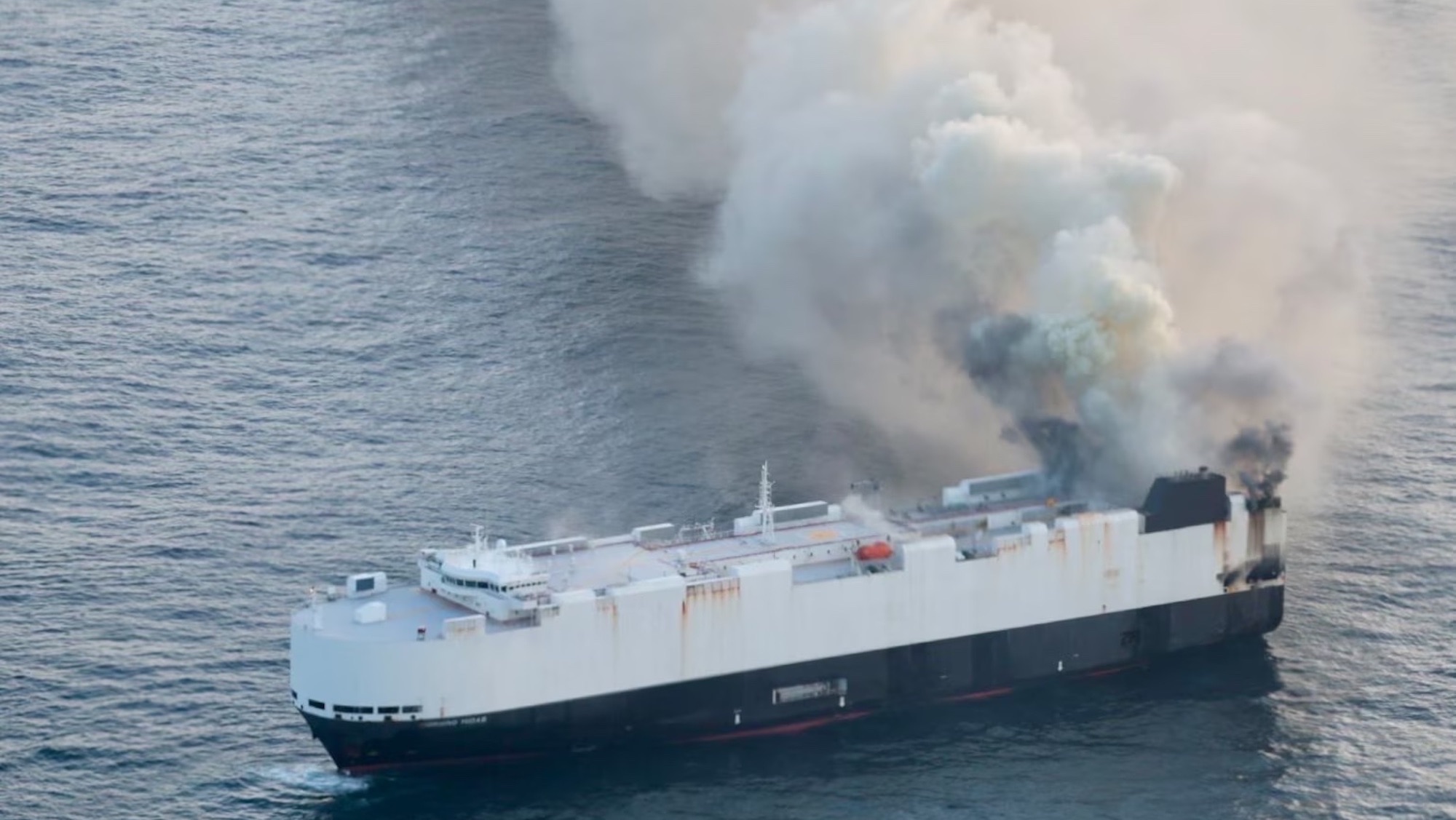Now Reading: An abandoned ship full of EVs is burning in the Pacific
-
01
An abandoned ship full of EVs is burning in the Pacific
An abandoned ship full of EVs is burning in the Pacific

Get the Popular Science daily newsletter💡
Breakthroughs, discoveries, and DIY tips sent every weekday.
A cargo ship transporting 3,000 cars was abandoned in the middle of the Pacific Ocean on Tuesday after a massive fire broke out. As of Friday, the ship was still burning. The blaze may have been fueled by the vehicles’ lithium-ion batteries, which are notoriously difficult to extinguish once ignited.
The ship, named Morning Midas, was reportedly carrying 3,000 cars on a journey from Yantai, China to Lázaro Cárdenas, Mexico. Of those vehicles, about 750 were fully electric or partial hybrids, powered at least in part by large lithium‑ion batteries that can short‑circuit and ignite extremely hot fires. Although the exact cause has yet to be determined, the Morning Midas crew reported smoke rising from the deck around midnight on Tuesday.
A representative from Zodiac Maritime, a UK-based ship manager overseeing the vessel, told The Register that the 22 sailors on board responded to the fire on Tuesday and attempted to extinguish it using the available onboard fire suppression systems. It wasn’t enough. As the blaze grew out of control, the crew reportedly issued a distress call and abandoned the ship in lifeboats. A nearby merchant vessel responded and rescued all 22 sailors, according to a statement released by the U.S. Coast Guard.
As for the Morning Midas, it remains afloat and burning in the middle of the Pacific Ocean, approximately 304 miles south of Adak, Alaska. It’s unclear what makes or models of cars were aboard—or whether any of them will be recoverable.
In a statement sent to Popular Science, Zodiac Maritime said the decision was made to prioritize safety crew and abandon the vessel due to the intensity of the fire. Zodiac has appointed salvage company Resolve Marine to respond to the ongoing fire. A separate team of salvage specialists are expected to arrive on the scene by June 9. Zodiac says it’s continuing to monitor the Midas’ status via its onboard satellite-connected systems.
“As the search and rescue portion of our response concludes, our crews are working closely with the vessel’s manager, Zodiac Maritime, to determine the disposition of the vessel,” US Coast Guard Seventeenth District Commander Rear Admiral Megan Dean said in a statement. “We are grateful for the selfless actions of the three nearby vessels who assisted in the response and the crew of motor vessel Cosco Hellas, who helped save 22 lives.”
Related: [Electric vehicle fires are rare, but challenging to extinguish]
What makes EV battery fires so hard to put out
You’ve likely seen images of firefighters struggling to put out fires in Teslas and other large EVs. While EVs are statistically less likely to catch fire than vehicles with internal combustion engines, the fires that do occur are significantly more difficult to extinguish. That’s due to a phenomenon known as thermal runaway. The large lithium-ion batteries that power EVs can short-circuit, triggering a chain reaction that eventually leads to ignition.
Thermal runaway can take days, or even weeks, to manifest. But once ignited, these fires burn much hotter than those caused by traditional internal combustion engines. They can also reignite after being extinguished, making them especially challenging for firefighters to manage.

Cargo ships are a perfect breeding ground for potentially dangerous fires. They’re often tightly packed with vehicles and have limited ventilation, meaning a fire in one vehicle can quickly spread to others. And while ships are typically equipped with some firefighting systems, those measures may be insufficient once a blaze spreads across multiple vehicles.
In 2022, a cargo ship transporting 4,000 vehicles caught fire in the Atlantic Ocean and eventually sank. Just a year later, another ship carrying around 3,000 vehicles caught fire off the Dutch coast. That incident killed one person and injured several others.
EV batteries are getting safer
Carmakers and battery suppliers are making efforts to improve the durability and reduce the risk of lithium ion fires. Just this week, Texas-based Alkegen, a major supplier of cell spacers used in batteries, announced commercial production of a new type of aerogel insulation they say can protect EV batteries from thermal runaway. Other companies have made improvements in monitoring systems to keep tabs on a battery’s health and more intelligent charging protocols that prevent damage from occurring from overcharging.
Even with those improvements though, the sheer scale of new EVs being shipped to meet increasing global demand means fires, either on ships or out on streets, aren’t likely to go away anytime soon.

More deals, reviews, and buying guides
The PopSci team has tested hundreds of products and spent thousands of hours trying to find the best gear and gadgets you can buy.




















